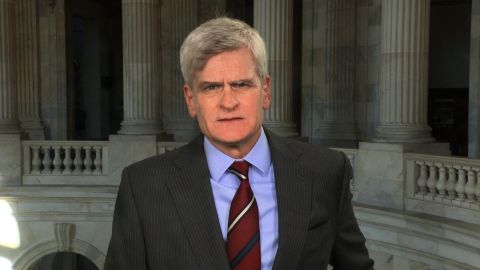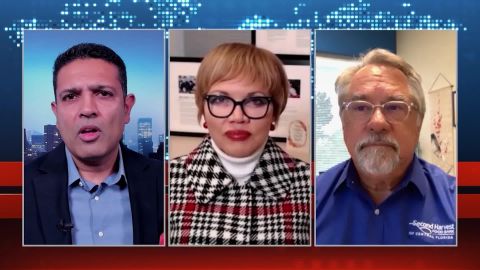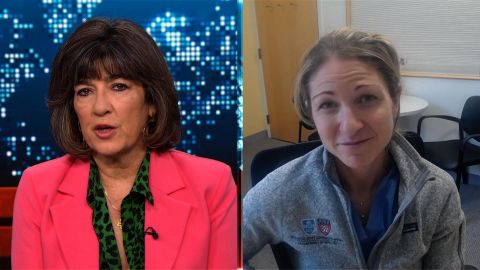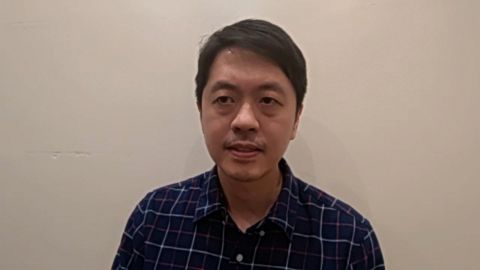Read Transcript EXPAND
CHRISTIANE AMANPOUR: Unemployment has surged and experts say hunger, hunger rates are higher than they’ve ever been in more than 20 years. Claire Babineaux-Fontenot is the CEO of Feeding America, which is the country’s largest network of food banks and Dave Krepcho runs the Second Harvest, that’s a food bank in Orlando, Florida. And here they are talking to our Hari Sreenivasan about the desperate need.
HARI SREENIVASAN: Christiane, thanks. Claire Babineaux-Fontenot and Dave Krepcho, thanks for joining us. Claire, I want to start with the sort of big picture here. When we see some of these numbers, they are startling but hard to grasp. Tell us how many people are food insecure right now in America.
CLAIRE BABINEAUX-FONTENOT, CEO, FEEDING AMERICA: Yes. I agree that they’re hard to grasp and my — one of my concerns is that people — human beings would get lost in those big numbers. So, our estimates are that as a result of the pandemic, that the rate of food insecurity in this country will go up to 50 million people. So, maybe it’s easier for your audience to grasp that that would mean that if you’re in the company of more than six people, about one in six individuals in this country are likely to be food insecure. About one in four kids. And what’s really challenging for me, all of that is challenging, but when you contemplate, that’s an average. That there are actually communities in this country that, where right now, one out every two kids is food insecure. So, really big numbers. A lot of pain. We’re right smack dab in the middle of a food crisis, Hari.
SREENIVASAN: Dave, you’ve been doing this for decades now. What has it been like to be on the front lines in Orlando through this pandemic and watching people come in to need help?
DAVE KREPCHO, PRESIDENT AND CEO, SECOND HARVEST FOOD BANK OF CENTRAL FLORIDA: It’s been surreal. I think that’s the best word. You know, when people hear of Orlando, they think of Disney and all the theme parks. How could you possibly have issues there? You know, but in the shadow of Cinderella’s castle, we have incredible need. You know, in all my years, I’ve been through fires, floods, hurricanes, tornadoes, 9/11 impact, the recession, COVID tops them all, by far. It’s not even close. So, it is surreal just to see the numbers of people that are reaching out. I mean, on an average day — well, since mid-March. We have distributing enough food for 300,000 meals each day, and it’s not enough.
SREENIVASAN: Claire, one in six Americans, at this point, you’re not talking about who we would consider in some stereotypes, poor, people who are on their last dollar, people who are homeless. We’re talking about a much bigger slice of America.
BABINEAUX-FONTENOT: You’re absolutely right. About 40 percent on average of people who are turning to us for help have never before relied on the charitable food system. So, these are people — they’re your neighbor. They’re the person right next door. And I’m glad you asked the question in the way that you did because there are so many myths around whom is it that food insecure before this pandemic started. There are a number — there are millions of working class, poor people in this country who can’t make ends meet. And then what this pandemic has shown us is there are also millions of people who are right — who are sitting right there on the brink. And so many vulnerable communities rely upon the very industries that are hardest hit by the pandemic. So, one of the horrors for me was — hidden in plain sight was that things were going to happen just like they did when we started closing restaurants, I knew that there were so many people who were going to have to turn to us and other sources because they just weren’t going to be able to make ends meet.
SREENIVASAN: David, I’m assuming that the hospitality industry is big in Orlando, kind of in the ripple effects of having the magic kingdom there. What is it like — and I’m sure you’ve seen this hundreds of times now. What is it like when you see that person who’s coming for the first time? What is going through their minds? What’s the similarity?
KREPCHO: Yes, we’re getting literally thousands of those people approaching us for food relief. And what’s disturbing is that they — well, first of all, they have never been in that position before, OK. And they start explaining themselves out of embarrassment and almost shame that they have to build the case for themselves that they need food. And it’s like you have to give them a gracious time-out and say, hey, we understand, you know, you’re in this through no fault of your own. And how can we help you? So, there’s a lot of that going on. And a lot of these folks put that request off as long as they could because of embarrassment, you know, I’ll give you just one example. You know, a lot of the food distributions are drive-throughs so there’s no touch, right? So, volunteers put the food in the back of a van or car. There was single father with about a 6 or 7-year-old son going through line and the volunteers putting food in the car and the son is watching this and whipped around, he goes, dad, are we going to eat today? The father just lost it, right. And he said, son, yes, we’re going to. As the dad pulled away, he mentioned to the volunteer that he had lost his job unexpectedly, you know, his wife had passed away. And him and his son hadn’t eaten in three days. And the Orlando area, OK — and again, like I’m saying, this is going on around the country, I mean, something’s terrible, terribly wrong here. They say that about one-third of the U.S. population, one-third, is living paycheck to paycheck and they don’t have $300 or $400 in their checking account to pay for any kind of emergency. So, when the wind blows, you know, they’re teetering on that tight rope. When the wind blows, you know, it’s blowing them over.
SREENIVASAN: Claire, I don’t know if most people realize where food banks get their food from. I know there are a couple of big federal programs, right now, The Farmers to Food Family Box program, there’s the Food Purchase and Distribution program, they are set to expire at the end of this calendar year.
BABINEAUX-FONTENOT: Yes.
SREENIVASAN: What kind of impact is that going to have around the country when these programs that have helped feed hundreds of thousands of people right now could zero out?
BABINEAUX-FONTENOT: Yes. So, let me give a little context for what that’s going to mean to us if there’s not intervention. So, our remarkable network was able to provide about 5 billion meals last year. 1.7 billion of them were as a result — direct result of federal commodities. We’re looking at a 60 percent increase in demand and if nothing else happens, we’re looking at a 50 percent decrease in those commodities. That is a perfect storm. So, right when people need help so desperately in the middle of the winter, in the middle of the pandemic, we’re looking at having less supply. I mean, it’s really critical. So, part of what we ask is for Congress to act. There is reason to be hopeful in some of the draft legislation that’s out there right now, but I’ve said more than once lately, I’ve seen a lot of drafts. I’d like to see some legislation, because while we’re thinking about it and trying to get it precisely right, people are struggling right now. Ordinarily, the vast majority of the food that we receive as a network comes from some form of donated food, right. So, it’s the federal government with commodities, it’s retail, it’s manufacturers. Right now, we’re seeing declines in those places, which is forcing our members to go out and buy more food than we’ve ever bought before. And also, because of or need to be safe, we have to have it boxed up in a certain way so we can do these mass distributions. All of that collides to have our members in the marketplace when according to the U.S. Bureau of Labor Statistics, retail grocery prices are at a 50-year high. So, our members are out there buying food that we didn’t have to buy in the past at a time when it costs so much more.
SREENIVASAN: David, what — one of the things Claire mentioned was this perfect storm. That demand was likely to increase. With your kind of ears on the ground, you’re likely meeting people who are just a couple of payments away from being evicted or people for whom any sort of unemployment insurance has run out or will run out in a matter of weeks.
KREPCHO: Unfortunately, homelessness is growing again. You know, incredible efforts to minimize that or reduce it, but it’s growing. It’s like one step forward and three steps back. We have single mothers with families living in storage sheds in Central Florida, and they’re being charged $500 a month. I mean, that’s disgusting. It should be illegal. Eviction notices are increasing. I was just talking to one of our feeding partners and, you know, they’re a fairly small operation but in the past week they had 18 families come to them and said, we have been evicted, you know, we need food, you know. Can you help us with some kind of rent payment somewhere? And all these programs, you know, they’re running out of money because of the demand that they’re facing. This pandemic has really laid bare some prior huge issues in this country from community. And one thing that exists across the country is lack of affordable housing. This is all interconnected. So, when you have a lack of affordable housing connected with low wages, you got a horrible cocktail right there for hardship.
SREENIVASAN: So, Claire, here we are about to turn the page to a new administration and the agriculture secretary, somebody who’s been on your board before, Tom Vilsack, what are the opportunities here? When — we’re not just talking about fixing the crisis that’s around this pandemic, but some of the deeper inequalities that it’s laid bare that David is pointing to.
BABINEAUX-FONTENOT: Yes. So, I have to tell you, I’m really optimistic about what the future represents. I believe that part of what we needed to do as a country was to — we needed certain things to be revealed, right. There were things hidden in plain sight and they need it to have lights shown on them and we have. So, as I contemplate what next year has in store for us, I think about some of the short-term interventions that are going to be necessary to be sure, like increasing commodities, like increasing the federal nutrition programs. Trying to track with the increase that we already have in the cost of groceries, track that in incremental increases in the federal nutrition programs. I think about that as — the federal nutrition programs, as being the short and mid-term solutions. But then beyond that, we must take a fresh look at our policies and we really need to finally address systemic issues. I think we need to seize upon the opportunity to stop assuming that the people who are not as impacted by these policies are better positioned to solve for them. We’ve got to bring people facing hunger, for instance, to the table as we come up with creative solutions for people facing hunger.
SREENIVASAN: David, if you had a bit of advice for the incoming Biden administration, not just what you’re dealing with today and the next couple of months, but the bigger picture?
KREPCHO: We — you know, we are out here in the trenches. We are not looking for government to solve all of this. OK. I want to make that message clear. My advice to them is to do as much as possible of inspiring and engaging the country to end hunger, OK, as a grand vision and then to work out how do you do that. And that takes local, state, federal government at the table, corporate America at the table, private family foundations, individual residents, everybody can play a part and does play a part. And just an example of that. If you can — I got a handwritten note in block letters from Savannah. She says, I’m a 7-year-old in school and, you know, I don’t want to see hungry people. She put a $20 bill in the envelope. You know, I mean, if you can can — I got like a handwritten note and block letters from Savannah, she goes, Mr. Krepcho, I’m a 7-year-old in school and, you know, I don’t want to see hungry people. And she put a $20 bill in the envelope, you know. I mean, if Savannah can do that, certainly the rest of us can do something. We can solve this. So, I am encouraged by that. But I would just say, maybe Tom Vilsack has to create a national food czar, you know. We have to get — elevate this food security thing to a much higher level and take it much more seriously. The other specific piece on legislation is to increase SNAP., our food stamp benefits, by, you know, 15 percent. You know, there’s a lot of myths around SNAP and who uses it and everything, but for every meal that a food bank provides, SNAP provides nine. OK. And all the SNAP dollars are economic drivers to local communities. So, it makes so much sense. And the S in SNAP, that acronym, is supplemental. Nobody can live — no family can live on $4.85 a day for a meal.
SREENIVASAN: Claire, how do you square this? When we look at this structurally, how is it possible that we could be so wealthy and at the same time have so many people in such need?
BABINEAUX-FONTENOT: I want to talk about through the lens of my own life where I am the product of the generosity of this remarkable country. I’ve had access to education that my parents didn’t have. They didn’t graduate from high school. My parents got to go to school. My grandparents were sharecroppers on both sides. None of them had the opportunity to go to school. I get to realize the American dream. There’s an American dream and there’s an American ideal. And that ideal, we have not lived up to that ideal. So, some of this is just counter to who we think we are. So, when we talk to little kids about eating — a picky eater, about eating all of their food, we will tell them, oh, baby, you got to eat your food because there are hungry kids in Africa, India, China. My whole life I’ve understood that we do not need to look to distant shores to find hunger. Hunger is right here in every county in this country there are challenging around food insecurity, and it’s simply not who we think of ourselves as. So, I think we are — I know we are a great nation. We can do so much when we set our minds to it. But people don’t solve for problems they don’t think they have. I think in this moment, we can see the issues, and that’s what makes me so optimistic we have to do something about it.
SREENIVASAN: Claire Babineaux-Fontenot and David Krepcho, thanks so much for joining us.
BABINEAUX-FONTENOT: Thank you for having me.
KREPCHO: You’re welcome.
About This Episode EXPAND
Pediatric surgeon Dr. Cornelia Griggs reflects on the past nine months she has spent on the front lines of the pandemic. Sen. Bill Cassidy (R-LA) explains where negotiations stand on a COVID relief bill. Former Hong Kong pro-democracy lawmaker Ted Hui discusses the struggle for democracy in his home country. Claire Babineaux-Fontenot and David Krepcho discuss food insecurity.
LEARN MORE



